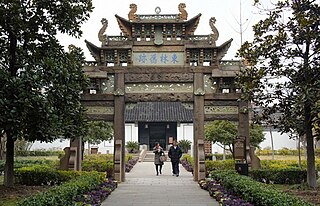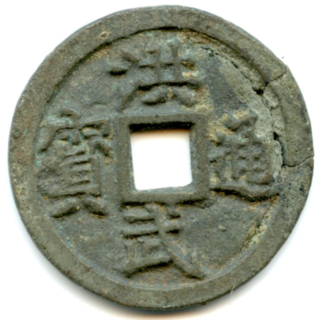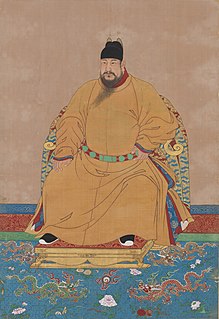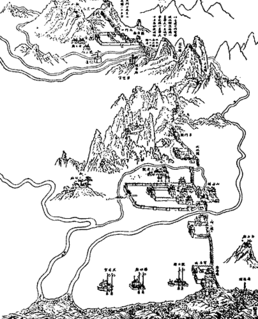 W
WThe Ming dynasty, officially the Great Ming, was the ruling dynasty of China from 1368 to 1644 following the collapse of the Mongol-led Yuan dynasty. The Ming dynasty was the last imperial dynasty of China ruled by Han Chinese. Although the primary capital of Beijing fell in 1644 to a rebellion led by Li Zicheng, numerous rump regimes ruled by remnants of the Ming imperial family—collectively called the Southern Ming—survived until 1662.
 W
WThis is a timeline of the Ming dynasty (1368–1644) from the rise of the Hongwu Emperor to the rise and establishment of the Qing dynasty.
 W
WYunnan under Ming rule saw the continuation of the tusi system instituted during the Yuan dynasty, increasing centralization, and Han migration into Yunnan.
 W
WThe 1494 Yellow River flood was a natural disaster in China during the Ming dynasty.
 W
WThe 1622 North Guyuan earthquake struck Ningxia, China on 25 October with a Richter magnitude of 7.0 and a maximum Mercalli intensity of X (Extreme). It was the only recorded big earthquake in western China for 148 years, between 1561 and 1709. The earthquake occurred on the "rake of the Zhongwei-Tongxin fault", with a mid-seismogenic depth of about 15 kilometres (9.3 mi).
 W
WJorge Álvares was a Portuguese explorer. He is credited as the first European to have reached China by sea during the Age of Discovery.
 W
WYongtongqiao, better known as Baliqiao, is a historic bridge located at the intersection of Tongzhou and Chaoyang districts in the east of Beijing, China. It passes over the Tonghui River (通惠河).
 W
WThe Beijing Ancient Observatory is a pretelescopic observatory located in Beijing, China. The observatory was built in 1442 during the Ming dynasty, and expanded during the Qing. It received major reorganization and many new, more accurate instruments from Europeans (Jesuits) in 1644.
 W
WChinese coinage in the Ming dynasty saw the production of many types of coins. During the Ming dynasty of China, the national economy was developed and its techniques of producing coinage were advanced. One early period example is the Bronze 1 cash. Obverse: "HUNG-WU T'UNG-P'AO" (洪武通寶). Reverse: blank. Average 23.8 mm, 3.50 grams.
 W
WThe Da Ming Baochao was a series of banknotes issued during the Ming dynasty in China. They were first issued in 1375 under the Hongwu Emperor. Although initially the Da Ming Baochao paper money was successful, the fact that it was a fiat currency and that the government largely stopped accepting these notes caused the people to lose faith in them as a valid currency causing the price of silver relative to paper money to increase. The negative experiences with inflation that the Ming dynasty had witnessed signaled the Manchus to not repeat this mistake until the first Chinese banknotes after almost 400 years were issued again in response to the Taiping Rebellion under the Qing dynasty's Xianfeng Emperor during the mid-19th century.
 W
WThe Da Ming Hunyi Tu is an extensive Chinese map. It was painted in colour on stiff silk and 386 x 456 cm in size. The original text was written in Classical Chinese, but on the surviving copy Manchu labels were later superimposed. The surviving copy of the map shows later revisions, and it is uncertain whether it is the original.
 W
WThe Donglin Academy, also known as the Guishan Academy, was a former Chinese educational institution in Wuxi, China. It was originally built in 1111 during the Northern Song dynasty; the neo-Confucian scholar Yang Shi (楊時) taught there, but the academy later fell into disuse and disrepair. The name "Donglin" was inspired by the Donglin Temple at the base of Mount Lu, Jiangxi. Yang Shi visited the Donglin Temple and felt that it was a good place for teaching. When he finished his scholarship, he travelled to Wuxi and saw that the layout of the academy was similar to the Donglin Temple, so he taught at that site for 18 years. The academy was thus called "Donglin Academy".
 W
WThe economy of the Ming dynasty (1368–1644) of China was the largest in the world during that period. It is regarded as one of China's three golden ages. The period was marked by the increasing political influence of the merchants, the gradual weakening of imperial rule, and technological advances.
 W
WGiven textual and archaeological evidence, it is thought that thousands of Europeans lived in Imperial China during the period of Mongol rule. These were people from countries traditionally belonging to the lands of Christendom during the High to Late Middle Ages who visited, traded, performed Christian missionary work, or lived in China. This occurred primarily during the second half of the 13th century and the first half of the 14th century, coinciding with the rule of the Mongol Empire, which ruled over a large part of Eurasia and connected Europe with their Chinese dominion of the Yuan dynasty (1271–1368). Whereas the Byzantine Empire centered in Greece and Anatolia maintained rare incidences of correspondence with the Tang, Song and Ming dynasties of China, the Roman papacy sent several missionaries and embassies to the early Mongol Empire as well as to Khanbaliq, the capital of the Mongol-led Yuan Dynasty. These contacts with the West were only preceded by rare interactions between the Han-period Chinese and Hellenistic Greeks and Romans.
 W
WThe Great White Pagoda, or Sarira Stupa of Tayuan Temple, is a brick stupa located at Mount Wutai of Wutai County, Shanxi province, China.
 W
WFutou (襆頭), also known as the wushamao (烏紗帽), is the headwear of Ming dynasty officials, consisting of a black hat with two wing-like flaps of thin, oval shaped boards on each side. According to the Da Ming Hui Dian (大明會典), ordinary citizens are not allowed to wear this headdress unless attending wedding ceremonies or events involving any noble families/officials. In modern China, wushamao is commonly used as a metaphor for officials and government posts.
 W
WThe Ming dynasty, officially the Great Ming or Empire of the Great Ming, founded by the peasant rebel leader Zhu Yuanzhang, known as the Hongwu Emperor, was an imperial dynasty of China. It was the successor to the Yuan dynasty and the predecessor of the short-lived Shun dynasty, which was in turn succeeded by the Qing dynasty. At its height, the Ming dynasty had a population of 160 million people, while some assert the population could actually have been as large as 200 million.
 W
WThe Hongwu Tongbao was the first cash coin to bear the reign name of a reigning Ming dynasty Emperor bearing the reign title of the Hongwu Emperor. Hongwu Tongbao cash coins officially replaced the earlier Dazhong Tongbao coins, however the production of the latter did not cease after the Hongwu Tongbao was introduced. The government of the Ming dynasty placed a greater reliance on copper cash coins than the Yuan dynasty ever did, but despite this reliance a nationwide copper shortage caused the production of Hongwu Tongbao cash coins to cease several times eventually leading to their discontinuation in 1393 when they were completely phased out in favour of paper money. In the year 1393 there were a total of 325 furnaces in operation in all provincial mints of China which had an annual output of 189,000 strings of cash coins which was merely 3% of the average annual production during the Northern Song dynasty.
 W
WThe Hundred-word Eulogy is a 100-character praise of Islam and the Islamic prophet Muhammad written by the Hongwu Emperor of China. Copies of it are on display in several mosques in Nanjing, China.
 W
WAs the Yuan dynasty ended, many Mongols as well as the Muslims who came with them remained in China. Most of their descendants took Chinese names and became part of the diverse cultural world of China. During the following Ming rule (1368–1644), Muslims truly adopted Chinese culture. Most became fluent in Chinese and adopted Chinese names and the capital, Nanjing, became a center of Islamic learning. As a result, the Muslims became "outwardly indistinguishable" from the Chinese.
 W
WThe Japan–Ming trade-ship flag is an object dating to 1584 preserved at the Yamaguchi Prefectural Archives that has been designated an Important Cultural Property of Japan due to its historical significance and the light it shines on trade and relations between Momoyama Japan and Ming China.
 W
WThe Jiangnan Examination Hall, near the Confucius temple, is located in the southern part of Nanjing, Jiangsu Province, China. It is the largest examination hall for imperial examination in ancient China.
 W
WLampacau or Lampacao, also known by other names, was a small island in the Pearl River Delta, which in the mid-16th century played an important role in Sino-Portuguese trade. Lampacau no longer exists as a separate island, as sedimentary deposits from the Pearl River system resulted in it becoming a part of a larger island.
 W
WThe late Ming peasant rebellions (明末民變) were a series of peasant revolts during the last decades of the Ming dynasty lasting from 1628–1644. They were caused by natural disasters in Shaanxi, Shanxi, and Henan. At the same time, the She-An Rebellion and Jurchen invasions forced the Ming government to cut funding for the postal service, which resulted in the mass unemployment of men in the provinces hit hard by natural disasters. Unable to cope with three major crises at the same time, the Ming dynasty collapsed in 1644.
 W
WLuzhou Laojiao is a Chinese liquor distilled from fermented sorghum. It is a baijiu of the "strong aroma" class. It is produced by Luzhou Laojiao Company Limited, which is headquartered in Luzhou, in southern Sichuan, China.
 W
WManchuria under Ming rule refers to the domination of the Ming dynasty over Manchuria, including today's Northeast China and Outer Manchuria. The Ming rule of Manchuria began with its conquest of Manchuria in the late 1380s after the fall of the Mongol Yuan dynasty, and reached its peak in the early 15th century with the establishment of the Nurgan Regional Military Commission, but the Ming power waned considerably in Manchuria after that. Starting in the 1580s, a Jianzhou Jurchen chieftain named Nurhaci (1558–1626), began to take control of most of Manchuria over the next several decades, and the Qing dynasty established by his son would eventually conquer the Ming and take control of China proper.
 W
WMandarin was the common spoken language of administration of the Chinese empire during the Ming and Qing dynasties. It arose as a practical measure, to circumvent the mutual unintelligibility of the varieties of Chinese spoken in different parts of China. Knowledge of this language was thus essential for an official career, but it was never formally defined. The language was a koiné based on Mandarin dialects, initially those spoken around Nanjing. A form based on the Beijing dialect became dominant by the mid-19th century and developed into Standard Chinese in the 20th century. In some 19th-century works, it was called the court dialect.
 W
WThe Southern Ming, officially the Great Ming, was a series of dynastic rump states ruled by the Zhu clan in southern China following the Ming dynasty's collapse in 1644. The Ming dynasty ended when Shun forces led by Li Zicheng captured Beijing and the last Ming emperor Chongzhen committed suicide. The Ming general Wu Sangui then opened the gates of the Shanhai Pass in the eastern section of the Great Wall to the multi-ethnic Qing banners, in hope of using them to annihilate the Shun forces. Ming loyalists fled to Nanjing, where they enthroned Zhu Yousong as the Hongguang Emperor, marking the start of the Southern Ming. The Nanjing regime lasted until 1645, when Qing forces captured Nanjing. Later, a series of pretenders held court in various southern Chinese cities.
 W
WAntonio de Morga Sánchez Garay was a Spanish soldier, lawyer and a high-ranking colonial official for 43 years, in the Philippines, New Spain and Peru, where he was president of the Real Audiencia for 20 years.
 W
WThe Pagoda of Cishou Temple, originally known as Yong'anwanshou Pagoda, is a 16th-century stone and brick Chinese pagoda located in the Buddhist Cishou Temple of Balizhuang, a suburb of Beijing.
 W
WThe Reign of Ren and Xuan (1424-1435) refers to the reigns of the Hongxi Emperor and Xuande Emperor, which was considered the height of the Ming dynasty's golden age. After the Xuande Emperor's death, the dynasty began to gradually decline.
 W
WSalt, salt production, and salt taxes played key roles in Chinese history, economic development, and relations between state and society. The lure of salt profits led to technological innovation and new ways to organize capital. Debate over government salt policies brought forth conflicting attitudes toward the nature of government, private wealth, the relation between the rich and the poor, while the administration of these salt policies was a practical test of a government's competence.
 W
WThe Southern Ming, officially the Great Ming, was a series of dynastic rump states ruled by the Zhu clan in southern China following the Ming dynasty's collapse in 1644. The Ming dynasty ended when Shun forces led by Li Zicheng captured Beijing and the last Ming emperor Chongzhen committed suicide. The Ming general Wu Sangui then opened the gates of the Shanhai Pass in the eastern section of the Great Wall to the multi-ethnic Qing banners, in hope of using them to annihilate the Shun forces. Ming loyalists fled to Nanjing, where they enthroned Zhu Yousong as the Hongguang Emperor, marking the start of the Southern Ming. The Nanjing regime lasted until 1645, when Qing forces captured Nanjing. Later, a series of pretenders held court in various southern Chinese cities.
 W
WThe Tomb of General Zu Dashou is one of the earliest pieces in the Royal Ontario Museum’s collections, and on the museum's list of Iconic Objects.
 W
WThe transition from Ming to Qing, Ming–Qing transition, or the Manchu unification of China from 1618 to 1683 saw the transition between two major dynasties in Chinese history. It was the decades-long conflict between the emergent Qing dynasty (清朝), the incumbent Ming dynasty (明朝), and several smaller factions in China. It ended with the rise of the Qing, the fall of the Ming and other factions, and the unification of Outer Manchuria, Mongolia, Xinjiang, Tibet, and Taiwan under the Qing Empire.
 W
WThe Wanshou Temple is a temple located at the Suzhoujie in Haidian District, Beijing. In addition to being a Buddhist temple, the Wanshou Temple also houses the Beijing Art Museum (北京艺术博物馆/北京藝術博物館).
 W
WThe White Lotus was a religious and political movement that appealed to many Han Chinese who found solace in worship of Wusheng Laomu, who was foretold to gather all her children at the millennium into one family.
 W
WWokou, which literally translates to "Japanese pirates" or "dwarf pirates", were pirates who raided the coastlines of China and Korea from the 13th century to the 16th century. The wokou came from Japanese, Korean, and Chinese ethnicities which varied over time and raided the mainland from islands in the Sea of Japan and East China Sea. Wokou activity in Korea declined after the Treaty of Gyehae in 1443, but continued in Ming China and peaked during the Jiajing wokou raids in the mid-1500s, but Chinese reprisals and strong clamp downs on pirates by Japanese authorities saw the wokou virtually disappear by the 1600s.
 W
WThe Yangshan Quarry is an ancient stone quarry near Nanjing, China. Used during many centuries as a source of stone for buildings and monuments of Nanjing, it is preserved as a historic site. The quarry is famous for the gigantic unfinished stele that was abandoned there during the reign of the Yongle Emperor in the early 15th century. In scope and ambition, the stele project is compared to other public works projects of Yongle era, which included the launching of the treasure fleet for Zheng He's maritime expeditions and the construction of the Forbidden City in Beijing.
 W
WThe Yongle Tongbao refers to Ming dynasty era Chinese cash coin produced under the reign of the Yongle Emperor. As the Ming dynasty didn't produce copper coinage at the time since it predominantly used silver coins and paper money as the main currency, the records vary on when the Yongle Emperor ordered its creation between 1408 and 1410, this was done as the production of traditional cash-style coinage had earlier ceased in 1393. The Yongle Tongbao cash coins were notably not manufactured for the internal Chinese market where silver coinage and paper money would continue to dominate, but were in fact produced to help stimulate international trade as Chinese cash coins were used as a common form of currency throughout South, Southeast, and East Asia.
 W
WThe Zhihua Temple is a Ming dynasty-era Buddhist temple in Beijing, China. It is located in the Lumicang (禄米仓) hutong, in the Chaoyangmen area of Dongcheng District, within the Second Ring Road to the north of Jinbaojie Street, west of the Yabaolu area. The temple was built in 1443 at the order of Wang Zhen, a powerful eunuch in the Rites Supervising Office of the court of the Zhengtong Emperor.
 W
WStandard cash, or regulation cash coins, is a term used during the Ming and Qing dynasties of China to refer to standard issue copper-alloy cash coins produced in imperial Chinese mints according to weight and composition standards that were fixed by the imperial government. The term was first used for Hongwu Tongbao cash coins following the abolition of large denomination versions of this cash coin series.
 W
WThe zuihuai is a specimen of the pagoda tree located in Jingshan Park, Beijing, China. It is a tourist attraction and national landmark in Jingshan Park. The Chongzhen Emperor, the last ruler of the Ming dynasty, allegedly hanged himself from the tree in 1644 after the imperial capital, Beijing, fell to rebel forces led by Li Zicheng.